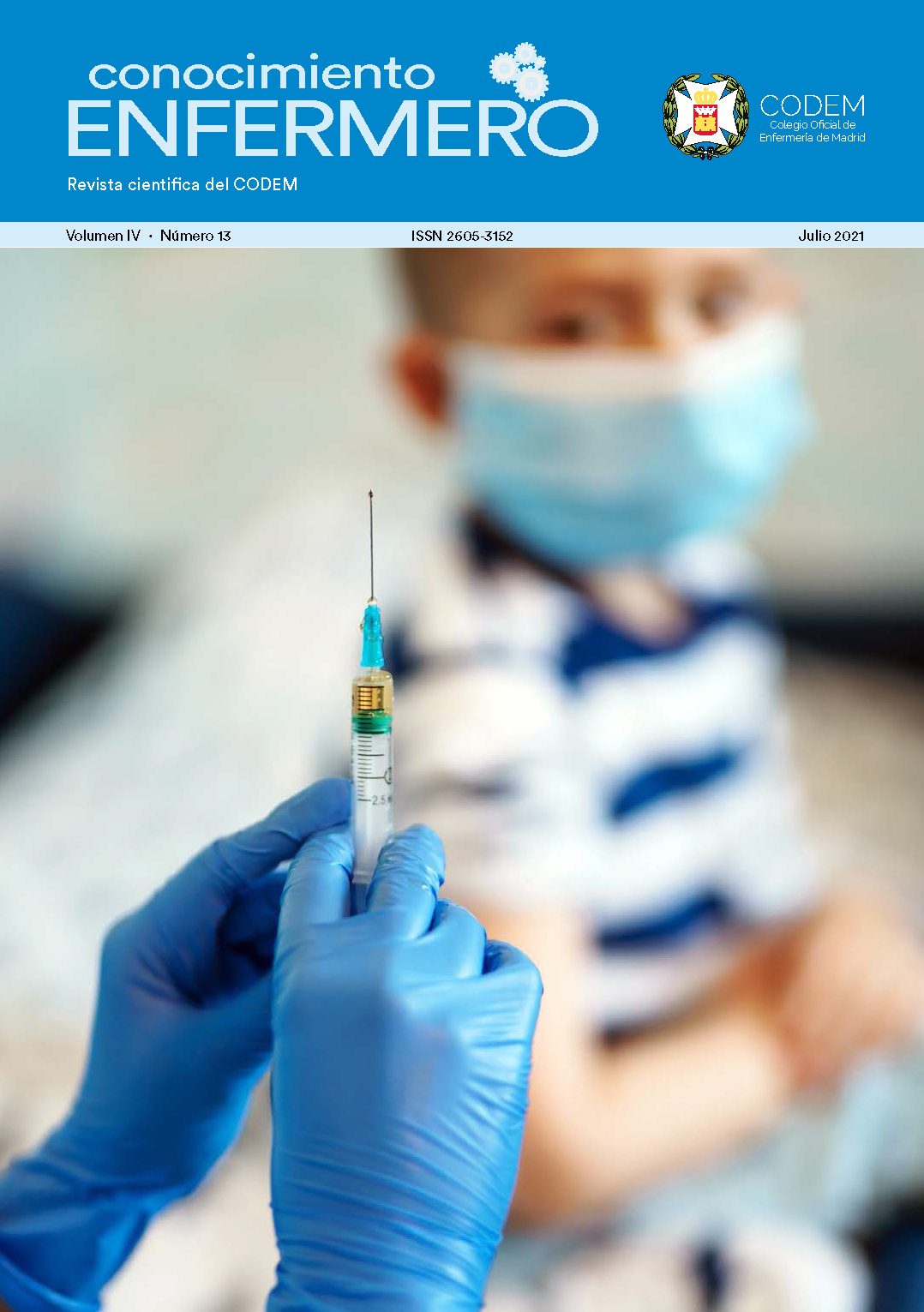Effectiveness of applying cold in combination with thermomechanical stimulation in order to reduce pain in pediatric vaccination
DOI:
https://doi.org/10.60108/ce.167Keywords:
pain; external thermomechanical stimulation; external cold; pediatric vaccination; buzzyAbstract
Introduction. Vaccination is usually a painful procedure in pedriatics. Pain can be defined as a biological feature that depends on several factors, adn therefore it is important to prevent it and reduce it as much as possible.
Objetive. Evaluate the effectiveness of applying cold and thermomechanic stimulation when using the Buzzy® device in order to reduce pain in pediatric vaccination.
Methodology. Random clinic tests taken on 154 children, from 2 months old, up to 6 years old, both included. The children have been divided in two random groups known as intervention group (using the Buzzy® device) and control group (common procedure). The pain assesment has been measured using the FLACC and WBFPS scales.
Results. The average pain measured using the FLACC scale has descreased 1,8 points in the intervention group. In addition, the average pain monitored by an external observer using the WBFPS scale has been reduced 3,74 points in comparison with the control group whilst the pain measured by autoevaluation has also been reduced in 3,22 points in the intervention group. In all cases, p <0,05.
Conclusion. the combined application of external cold and thermomechanic stimulation by using the Buzzy® device, reduces pain in pediatric vaccination.
References
2. Curso formación continuada en Dolor en Pediatría. [Fecha de consulta: 20/09/2018]. Disponible en: https://www.sepeap.org/wp-content/uploads/2014/01/DOLOR_Valoracion.pdf
3. Acevedo González JC. Ronald Melzack and Patrick Wall. La teoría de la compuerta. Más allá del concepto científico dos universos científicos dedicados al entendimiento del dolor. Rev Soc Esp Dolor. 2013;20(4):191-202.
4. Buzzy™ - O que é o Buzzy™. [Fecha de consulta: 03/10/2018 ] Disponible en: http://www.buzzy4shots.com.br/page17/index.html
5. Buzzy helps control needle pain & fear from shots IVs injections. [Fecha de consulta: 05/10/2018]. Disponible en: https://buzzyhelps.com/
6. Leyva Carmona M, Torres Luna R, Ortiz San Román L, Marsinyach Ros I, Navarro Marchena L, Mangudo Paredes AB et al. Documento de posicionamiento del Grupo Español para el Estudio del Dolor Pediátrico (GEEDP) de la Asociación Española de Pediatría sobre el registro del dolor como quinta constante. An Pediatr (Barc). 2019;91(1):58.e1 – 58.e7. Disponible en: https://www.sciencedirect.com/science/article/pii/S1695403319301924
7. Beltramini A, Milojevic K, Pateron D. Pain Assessment in Newborns, Infants, and Children. Pediatric annals. 2017;46(10):e387-95.
8. Inal S, Kelleci M. The effect of external thermomechanical stimulation and distraction on reducing pain experienced by children during blood drawing: Pediatr Emerg Care. 2017.
9. Moadad N, Kozman K, Shahine R, Ohanian S, Badr LK. Distraction using the BUZZY for children during an IV insertion. J Pediatr Nurs. 2016;31(1):64-72.
10. Canbulat N, Ayhan F, Inal S. Effectiveness of external cold and vibration for procedural pain relief during peripheral intravenous cannulation in pediatric patients. Pain Manag Nurs. 2015;16(1):33-9.
11. Bergomi P, Scudeller L, Pintaldi S, Dal Molin A. Efficacy of Non-pharmacological Methods of Pain Management in Children Undergoing Venipuncture in a Pediatric Outpatient Clinic: A Randomized Controlled Trial of Audiovisual Distraction and External Cold and Vibration. J Pediatr Nurs. 2018;42:e66-72.
12. Canbulat Şahiner N, İnal S, Sevim Akbay A. The effect of combined stimulation of external cold and vibration during immunization on pain and anxiety levels in children. J Perianesth Nurs. 2015;30(3):228-35.
13. Redfern R et al. Effects Of Thermomechanical Stimulation During Vaccination On Anxiety, Pain, And Satisfaction In Pediatric Patients: A Randomized Controlled Trial. Journal of Pediatric Nursing. 2018;38:1–7.
14. Instrucción del director general de coordinación de la asistencia sanitaria por la que se establece hasta 16 años la edad de atención pediátrica, a efectos de asistencia sanitaria en los centros de atención hospitalaria. [Fecha de consulta: 18/10/2018]. Disponible en: https://www.csif.es/sites/default/files/field/legado/202028/160218_instrampliacionedadpediatrica_pdf_73986.pdf
15. Vacuna MENINGOCOCO B | Comité Asesor de Vacunas de la AEP. [Fecha de consulta: 15/10/2018]. Disponible en: https://vacunasaep.org/familias/vacunas-una-a-una/vacuna-meningococo-b
16. García Sánchez N, Merino Moína M, García Vera C, Lacarta García I, Carbonell Muñoz L, Pina Marqués B et al. Alivio del dolor y el estrés al vacunar. Síntesis de la evidencia. Recomendaciones del Comité Asesor de Vacunas de la AEP. Rev Pediatr Aten Primaria. 2015 [Fecha de consulta: 20-11-19];17(68):317-27. Disponible en: http://dx.doi.org/10.4321/S1139-76322015000500006
17. Lalana Josa P, Royo Pérez D, Elías Villanueva E, Romeo Lázaro E, Bamala Cuartero C, Galindo Rubio C. Utilización de crema anestésica para minimizar el dolor en niños previa a venopunción para extracción sanguínea. Bol Pediatr Arag Rioj Sor. 2017;47(3): 85.
18. Saitua Iturriaga G, Aguirre Unceta – Barrenechea A, Suárez Zárate K, Zabala Olaechea I, Rodríguez Núñez A, Romera Rivero MM. Efecto analgésico de la lactancia materna en la toma sanguínea del talón en el recién nacido. An. Pediatr. 2009;71(4):310-3.
19. Álvarez A, Mercadal M, García – Algar O. Utilización de anestésico local fuera de ficha técnica. An Pediatr (Barc). 2013;79(1):56-63. Disponible en: https://www.analesdepediatria.org/es-utilizacion-anestesico-local-fuera-ficha-articulo-S1695403312004687#bib0040
20. Tüfekci FG, Celebioğlu A, Küçükoğlu S. Turkish children loved distraction: using kaleidoscope to reduce perceived pain during venipuncture. J Clin Nurs. 2009;18(15):2180-6. Disponible en: https://www.ncbi.nlm.nih.gov/pubmed/19583650
Additional Files
Published
Issue
Section
License
En caso de que el artículo sea publicado, los autores aceptan transferir todos los derechos del trabajo presentado, incluidos los derechos de autor y aquellos relativos a la transmisión electrónica, exclusivamente a CODEM, de manera universal, en todos los idiomas, una vez que el trabajo haya sido aceptado para su publicación dentro de la revista electrónica CONOCIMIENTO ENFERMERO.
El autor podrá hacer copias ilimitadas del trabajo para uso docente, reutilizarlo en su totalidad o parcialmente en un libro escrito por el autor o hacer copias para su distribución en la institución en la que trabaja. CODEM hará mención al nombre del autor en las publicaciones que se realicen del trabajo.


